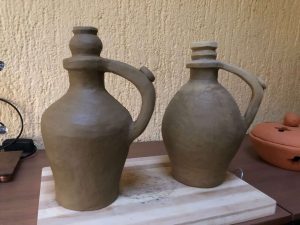Magija gline je tiha nagrada za učenje o glini i keramici
Ceramics is the art and craft of shaping and processing clay into objects that can be used or decorated, and then fired in a kiln at high temperatures. This process allows for the creation of durable, functional, or decorative items such as tableware, sculptures, and tiles. Ceramics combines creativity and technique, offering endless possibilities for expression through color, form, and texture.
About Types of Clay
- Upon entering the world of ceramics, I discovered that there are several types of clay, each with its own characteristics such as texture, color, and firing temperature. The type of clay we choose depends on the purpose and kind of object we want to create. The main types of clay used in ceramics are:
- Red Clay (Terra Cotta) – a clay rich in iron that gives red or brown tones, easy to shape, and commonly used for making tableware, garden sculptures, and decorative objects.
- White clay (porcelain clay) – clay with a very fine texture and a high content of kaolin, which makes it suitable for making fine and elegant items such as porcelain figurines and tableware
- Gray clay (stone clay) – clay that contains a higher amount of minerals, giving it a gray-brown color, and is used for making functional items such as pottery and ceramic tiles
- Plastic clay (kaolin) – clay ideal for shaping and used for making items that require fine modeling techniques
Additional Materials
Besides clay, materials in ceramics include grog to increase strength and resistance to high temperatures, quartz – which improves the clay’s texture and stability during firing, feldspar – a mineral used in glaze, and flux – a heat enhancer, as well as glaze – a mixture applied to ceramics for protection and decoration.
Clay as a Medium of Expression
Ceramics offers incredible freedom in expressing creativity and is a unique art form because it combines aesthetics and functionality. Working with clay is relaxing and meditative. The final result is literally a product shaped through interaction with nature, time, and elements — heat, moisture, and temperature. It unites technique, art, and emotion, making each piece unique and one of a kind.
Basic Stages of Making Ceramic Objects
Preparation of clay is the first step, which involves removing air bubbles from fresh clay and softening it by mixing to make it suitable for shaping.
Clay shaping can be done in various ways – hand modeling, shaping on a potter’s wheel, or casting into a mold.
The oldest and most basic clay shaping technique is hand-building without any tools. Shapes are created using fingers and palms, and this technique allows great freedom in creating sculptures and unique objects.
The technique of making objects by turning on a potter’s wheel uses a rotating wheel to shape clay into symmetrical forms such as dishes, vases, and bowls, using fingers and additional tools. This technique allows for precision and balance in creating pieces.
The slip casting technique involves pouring liquid clay (called slip) into plaster molds, where it hardens and takes the shape of the mold. This technique allows the production of series of identical items like tiles or dishes with great precision.
Using the slab building technique, pieces of clay are first shaped into flat slabs, which are then cut and joined into various forms such as boxes, dishes, or sculptures.
A widely used technique is coil building, which involves shaping objects from long rolls (coils) of clay that are stacked and joined one on top of the other. It is a very suitable form of artistic expression.
In addition to shaping clay in various ways, pieces are further refined by decorating them through carving, engraving, or impressing different patterns and motifs into the clay surface using stamps or tools.
Drying follows after shaping; the pieces must dry slowly to prevent cracking. The drying must be even, so the process takes several days.
The first firing of a piece in a kiln is done once it is completely dry. This firing is known as the “bisque” firing. It strengthens the piece and removes all moisture.
Glazing is done after the bisque firing. The pieces are painted with ceramic colors and coated with glaze. The glaze can be transparent or colored, and it gives the pieces color, shine, and protection. There are many types of glazes, ranging from matte to glossy, and different application techniques such as brushing, pouring, or dipping the piece into the glaze.
My Beginnings
My first clay objects were made using the coil building technique. At first, I had many ideas in my mind, but not the ability to transform those ideas into clay objects. They say that clay “remembers” and returns to its original shape. No matter how much I tried to control it, I felt like it was controlling me. But over time, I connected with that clay, and some beautiful first functional pieces were created quite quickly. Each new piece was an inspiration for more complex creations and for exploring new modeling and decorating techniques.

If you want to learn more, take a look 7 ključnih koraka kako izraditi keramički predmet od gline.
